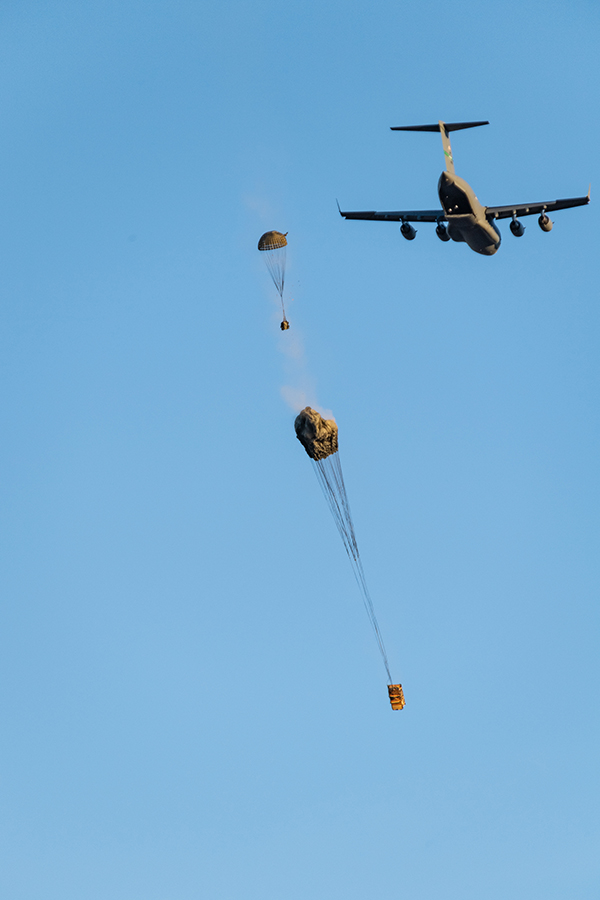Stay Up to Date
Submit your email address to receive the latest industry and Aerospace America news.
The Aerodynamic Decelerator Systems Technical Committee focuses on development and application of aerodynamic decelerator systems and lifting parachutes, pararotators, and inflatables for deceleration, sustentation and landing of manned and unmanned vehicles.
The U.S. Defense Department has a growing need to provide sufficient standoff for strategic lift to maintain survivability in highly contested anti-access/area denied environments. In response, the Combat Capabilities Development Command Soldier Center in Natick, Massachusetts, DEVCOM-SC for short, has committed to the development of the Squad Operations Advanced Resupply autonomous aircraft system. SOAR aircraft will be deployed from conventionally piloted cargo planes to provide a timely long-range precision delivery solution for dispersed forces operating within an A2/AD “bubble,” therefore reducing risks to Air Force personnel and aircraft. Flight testing of this Phase II system was conducted in August, and the system was displayed at Project Convergence 22 at Camp Pendleton in California from October through November. SOAR’s unique gravity deployment begins with a platform rolling out of the cargo plane and falling in a vertical orientation under a 28-foot (8.5-meter) diameter drogue parachute. SOAR slides off the platform and then its two small (turbine) jet engines turn on, and the vehicle shifts to horizontal flight. The engines turn off at 400 feet above the ground near the drop zone, and the vehicle descends to the surface under a Pocket G-12 parachute. These flights will be followed by initiation of the Phase III development aimed at further advancing this technology in fiscal years 2023 through 2025.
Also, DEVCOM-SC rapidly fielded the High Altitude Aerial Resupply System II technology, an airdropped storage container controlled by a stabilizer and main parachute, to U.S. Special Operations Command in a process that started in September 2021 and concluded in December. HAARS II employs a high-altitude, low-opening parachute concept of operation using existing Army parachutes for low cost. The system provides a GPS-denied airdrop capability that offers a high altitude release for enhanced aircraft safety, improved accuracy over more standard airdrop options and a low velocity impact that increases payload survivability. When it deploys from the aircraft, it uses a 15-foot (4.6-meter) ring slot parachute to descend at high velocity for much of the time aloft. As it approaches a preset altitude above the target, its Wireless Activation Device mechanically initiates deployment of a G-12E parachute while the Multi-Loop Release system reduces the forces on the mechanical actuator.
To enable C-17s to airdrop more Joint Light Tactical Vehicles, DEVCOM-SC worked with the Air Force last December and January of this year to execute the first tests from a C-17 of the Gravity Air Drop System method in a series of flights at the U.S. Army Yuma Proving Ground in Arizona. GADS utilizes the Aerial Delivery System rails of the C-17, but in this case, gravity alone extracts the payload instead of a parachute. Like the Dual Row Airdrop System parachute deployment method, the gravity method involves deploying a static line with a 8.5-meter ring slot drogue followed by a cluster of up to six G-11D or G-16 main parachutes. This airdrop method is a key enabler for doubling the C-17’s capacity to airdrop the Joint Light Tactical Vehicle. U.S. Transportation Command is sponsoring this project.
For ship-based launches, DEVCOM-SC continued to develop an autonomous powered parafoil/paraglider system for Transportation Command. This tethered parafoil/glider will be launched from standoff ranges to deliver fuel, ammunition or other cargo to ashore-side warfighters without the cost, complexity and logistics tail of helicopter operations. The ship-launched prototype vehicle, known as RESPOND, short for Replenishment from Ships to Point-of-Need Delivery, is also being leveraged by DEVCOM-SC’s other projects under the Aerial Delivery Division as a test platform for data collection and sensor integration into larger, multimodal powered parafoil systems. Testing over the next several months will aim to add autonomous flight capabilities during periods of occupied flight testing eventually leading to fully autonomous flight in fiscal year 2023.
The year was also busy for spacecraft parachute landing systems. Two SpaceX Cargo Dragons and two Crew Dragons splashed down under parachutes after missions to the International Space Station. Boeing’s unoccupied Starliner capsule returned in May, completing the Orbital Flight Test-2 ISS mission. Meanwhile, Blue Origin conducted four New Shepard suborbital missions from Texas, three of them with passengers and one uncrewed. An unoccupied NASA Orion capsule launched was expected to splash down in December after its November launch aboard a Space Launch System rocket.
Stay Up to Date
Submit your email address to receive the latest industry and Aerospace America news.




